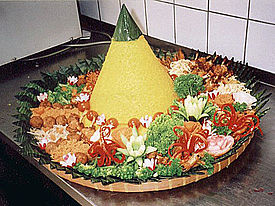Tumpeng

Tumpeng, the cone shaped rice surrounded by assorted Indonesian dishes.
|
|
| Course | main course |
|---|---|
| Place of origin | Indonesia |
| Region or state | Nationwide in Indonesia, but most prevalent in Javanese cuisine |
| Associated national cuisine | Indonesian |
| Serving temperature | hot or room temperature |
| Main ingredients | Cone shaped rice, urab (vegetables in shredded coconut), fried chicken, fried tempeh, boiled marble egg, shredded omelette, salted anchovy and peanuts |
| Variations | tumpeng robyong, tumpeng putih, tumpeng nasi uduk, tumpeng slametan (nasi kuning) |
| |
|
Tumpeng is a cone-shaped rice dish like mountain with its side dishes (vegetables and meat). Traditionally featured in the slamatan ceremony, the cone shape of rice is made by using cone-shaped woven bamboo container. The rice itself could be plain steamed rice, uduk rice (cooked with coconut milk), or yellow rice (uduk rice colored with kunyit (turmeric)).
The cone shaped rice erected on tampah (rounded woven bamboo container) covered with banana leaf, and surrounded by assorted of Indonesian dishes. In 2013, Indonesian Ministry of Tourism and Creative Economy promoted tumpeng as one among 30 Indonesian culinary icons, and finally elevate its status as the official national dish of Indonesia in 2014, describe it as "the dish that binds the diversity of Indonesian various culinary traditions."
People in Java, Bali and Madura usually make Tumpeng to celebrate important event. However, all Indonesians are familiar with Tumpeng. The philosophy of Tumpeng is related to the geographical condition of Indonesia, especially Java as fertile island with numerous mountains and volcanos. Tumpeng dated back to ancient Indonesian tradition that revered mountains as the abode of hyangs, the spirit of ancestors and gods. The cone-shaped rice meant to mimics the holy mountain. The feast served as somekind of thanks giving for the abundance of harvest or any other blessings.
Tumpeng is a symbol of gratitude, in gratitude ceremony (syukuran or slametan), after the people pray, the top of tumpeng is cut and delivered to the most important person. He or she may be the group leader, the oldest person, or the beloved one. Then, all people in the ceremony enjoy the tumpeng together. With tumpeng, people express the gratitude to God and appreciate togetherness and harmony. An annual ceremony involving tumpeng is commonly called 'tumpengan'.
...
Wikipedia
